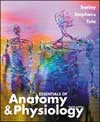 |
1 |  | 
Which of these is NOT a paranasal sinus? |
|  | A) | ethmoidal sinus |
|  | B) | frontal sinus |
|  | C) | mastoid sinus |
|  | D) | maxillary sinus |
|  | E) | sphenoidal sinus |
 |
 |
2 |  | 
Which of these opens into the nasopharynx? |
|  | A) | auditory tube |
|  | B) | external nares |
|  | C) | nasolacrimal ducts |
|  | D) | paranasal sinuses |
|  | E) | all of these |
 |
 |
3 |  | 
The largest cartilage in the larynx is the |
|  | A) | arytenoid cartilage. |
|  | B) | cricoid cartilage. |
|  | C) | corniculate cartilage. |
|  | D) | cuneiform cartilage. |
|  | E) | thyroid cartilage. |
 |
 |
4 |  | 
Which of these structures has no cartilage surrounding it? |
|  | A) | primary bronchi |
|  | B) | secondary bronchi |
|  | C) | terminal bronchioles |
|  | D) | larynx |
|  | E) | trachea |
 |
 |
5 |  | 
Visceral pleura is found |
|  | A) | inside the terminal bronchioles. |
|  | B) | on the surface of the lung. |
|  | C) | on the walls of the thorax, diaphragm, and mediastinum. |
|  | D) | in the trachea and bronchi. |
 |
 |
6 |  | 
For inspiration during labored breathing, which of these muscles is NOT contracted? |
|  | A) | diaphragm |
|  | B) | external intercostal muscles |
|  | C) | internal intercostal muscles |
|  | D) | pectoralis minor muscles |
|  | E) | sternocleidomastoid muscles |
 |
 |
7 |  | 
Which of these statements about air flow into the lungs is incorrect? |
|  | A) | At the end of expiration, alveolar pressure is equal to atmospheric pressure; no air flows. |
|  | B) | During inspiration, alveolar pressure is less than atmospheric pressure, and air flows into the alveoli. |
|  | C) | At the end of inspiration, alveolar pressure and atmospheric pressure are equal; no air is flowing. |
|  | D) | For expiration, thoracic volume decreases, alveolar pressure decreases, and air flows out. |
|  | E) | During inspiration, the volume of the thoracic cavity increases. |
 |
 |
8 |  | 
Recoil of the lungs occurs because of |
|  | A) | heavy internal organs that pull the ribs downward. |
|  | B) | extra gas pressure inside the thoracic cavity. |
|  | C) | surface tension of the fluid that lines the alveoli. |
|  | D) | elastic fibers in the connective tissue of the lungs. |
|  | E) | both c and d |
 |
 |
9 |  | 
Surfactant |
|  | A) | reduces surface tension of the fluid lining the alveoli. |
|  | B) | increases pleural pressure. |
|  | C) | decreases alveolar pressure. |
|  | D) | makes inspiration more difficult. |
|  | E) | can cause a pneumothorax. |
 |
 |
10 |  | 
Given these events: 1. air flows into the lungs 2. alveolar volume increases 3. thoracic volume increases 4. pleural pressure decreases 5. alveolar pressure decreases, Arrange them in the correct order as they occur during inspiration. |
|  | A) | 1,2,3,4,5 |
|  | B) | 2,5,1,3,4 |
|  | C) | 3,4,2,5,1 |
|  | D) | 4,5,2,1,3 |
|  | E) | 5,1,3,4,2 |
 |
 |
11 |  | 
The volume of air inspired or expired during quiet breathing is |
|  | A) | residual volume. |
|  | B) | inspiratory reserve volume. |
|  | C) | expiratory reserve volume. |
|  | D) | vital capacity. |
|  | E) | tidal volume. |
 |
 |
12 |  | 
If a person's vital capacity is 4500 mL, her expiratory reserve volume is 1000 mL, and her inspiratory reserve volume is 3000 mL, her tidal volume is |
|  | A) | 3500 mL |
|  | B) | 2000 mL |
|  | C) | 1500 mL |
|  | D) | 1000 mL |
|  | E) | 500 mL |
 |
 |
13 |  | 
If the atmospheric pressure is 760 mm Hg, and it is composed of 80% nitrogen and 20% oxygen, then the partial pressure of oxygen in the air is |
|  | A) | 152 mm Hg |
|  | B) | 486 mm Hg |
|  | C) | 608 mm Hg |
|  | D) | 740 mm Hg |
|  | E) | 760 mm Hg |
 |
 |
14 |  | 
Oxygen and carbon dioxide move through the respiratory membrane and into and out of cells by the process of |
|  | A) | active transport. |
|  | B) | cotransport. |
|  | C) | diffusion. |
|  | D) | exocytosis. |
|  | E) | facilitated diffusion. |
 |
 |
15 |  | 
Which of these statements concerning respiration is NOT true? |
|  | A) | Higher brain centers can modify the activity of the respiratory center. |
|  | B) | A decrease in pH of the blood increases respiration rate. |
|  | C) | The Hering-Breuer reflex limits the extent of expiration. |
|  | D) | An increase in carbon dioxide in the blood causes pH to decrease. |
|  | E) | Low oxygen levels in the blood increase respiration rate. |
 |



 2002 McGraw-Hill Higher Education
2002 McGraw-Hill Higher Education